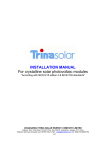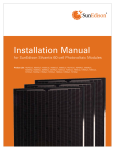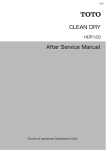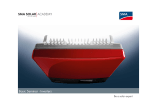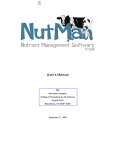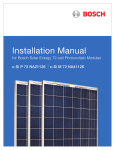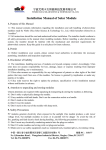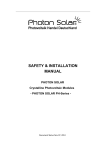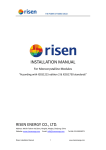Download INSTALLATION MANUAL For crystalline solar modules According
Transcript
INSTALLATION MANUAL For crystalline solar modules According with IEC61215&IEC61730 standard 1. POWER MODULE JSPV Solar Photovoltaic modules consist of a series of electrically interconnected crystalline silicon solar cells, which are permanently encapsulated between a tempered glass superstrate and substrate. The entire laminate is secured within an anodized aluminum frame for structural strength; ease of installation, and to protect the cells from the most severe environmental conditions. 2. APPLICATIONS JSPV solar SPV modules are a highly reliable, virtually maintenance-free, direct current (DC) power source, designed to operate most efficiently in sunlight. JSPV solar series modules are ideal to power remote homes, recreational vehicles, water pumps, telecommunication systems and many other applications either with or without the use of storage batteries. 3. PERMIT Before installing your system, contact local authorities to determine the necessary permitting, installation and inspection requirements. 4. DISCLAIMER OF LIABILITY The installation, handling and use of JSPV Solar Crystalline series modules are beyond company control. Accordingly, JSPV Solar does not assume responsibility for loss, damage, injury or expense resulting from improper installation, handling, use or maintenance. JSPV Solar assumes no responsibility for any infringement of patents or other rights of third parties that may result from use of the module. No license is granted by implication or under any patent or patent rights. JSPV solar reserves the right to update the product, specifications or this installation Manual without prior notice. 5. SAFETY PRECAUTIONS • • • • • • • • • • • The SPV modules installation should be carried out by qualified personnel only. All installation and safety instructions should be understood before attempting to install, wire, operate or maintain the modules. Use properly insulated tools and appropriate protective equipment to reduce risk of electric shock. Do not stand or step on the module. Do not damage or scratch the front- or backside surfaces of the module. Never use a module with broken glass or torn substrate. Broken modules cannot be repaired and contact with any module surface or frame can lead to electrical shock. Do not disassemble the modules or remove any part of the module. Never leave modules unsecured. Protect plug contacts against soiling; do not make any plug connections using soiled plug contacts. For rooftop installations, the modules should be mounted over a fire resistant covering rated for such an installation. Do not install or handle modules when they are wet or during periods of high wind. 6. CLIMATE CONDITION Install the JSPV Solar Crystalline series modules in the following conditions: • • • • • Ambient temperature: Operating temperature: Storage temperature: Humidity: Mechanical Load Pressure: -40°C to +40°C. -40°C to +85°C. -20°C to +40°C. below 85RH% below 112.78lb / ft2 (5400Pa)*. *Note: the mechanical load bearing (include wind and snow loads) of the module is based on the mounting methods. The professional system installer must be responsible for mechanical load calculation according to the system design. 7. SITE SELECTION In most applications, JSPV solar SPV modules should be installed in a location where they will receive maximum sunlight throughout the year. In the Northern Hemisphere, the module should typically face south, and in the Southern Hemisphere, the modules should typically face north. Modules facing 30 degrees away from true South (or North) will lose approximately 10 to 15 percent of their power output. If the module faces 60 degrees away from true South (or North), the power loss will be 20 to 30 percent. When choosing a site, avoid trees, buildings or obstructions, which could cast shadows on the solar photovoltaic modules especially during the winter months when the arc of the sun is lowest over the horizon. Shading causes loss of output, even though the factory fitted bypass diodes of the SPV module will minimize any such loss. Do not install the SPV module near naked flame or flammable materials. Do not install the SPV module in a location where it would be immersed in water or continually exposed to water from a sprinkler or fountain etc. Do not install the SPV module in a marine environment and/or area where salty wind hit directly. Do not install the SPV module in Corrosive environment, such as corrosive salt area or sulfurous area, etc. 8. MODULE TILT ANGLE JSPV Solar SPV modules connected in series should be installed at same orientation and angle. Different orientation or angle may cause loss of output power due to difference of amount of sunlight exposed to the module. JSPV Solar SPV modules produce the most power when they are pointed directly at the sun. For installations where the SPV modules are attached to a permanent structure, the SPV modules should be tilted for optimum winter performance. As a rule, if the system power production is adequate in winter, it will be satisfactory during the rest of the year. The module tilt angle is measured between the solar modules and the ground (Figure 1). Optimal tilting of SPV module is almost the same as the latitude of installation location. SUNLIGHT MODULE TILT ANGLE HORIZONTAL Figure 1. SPV Module Tilt Angle 9. Mechanical drawing of SPV module Frame cross section (long side) Frame cross section (short side) Figure2. SPV module Mechanical drawing* SPV module type JSMM-***-24 JSMP-***-16 JSMP-***-20 JSMP-***-24 Cell type Mono-crystalline-Si Poly-crystalline-Si Poly -crystalline-Si Poly -crystalline-Si Cell quantity 6*12 6*8 6*10 6*8 Dimensions A*B*C (mm) 1580*808*35 1316*992*40 1650*992*40 1956*992*45 Installation hole E*F (mm) 1180*758 916*942 1225*942 1656*942 Cable length G (mm) 1000 1000 1000 1000 Frame dimension H*C*I (mm) 8*35*35 11*40*35 11*40*35 11*45*35 Table 1: SPV module installation mechanical dimensions *Note: − SPV module JSMM-***-24 is used here as an example. − Where “***” is the rated power of the related SPV module. 10. MOUNTING AND NOTES Systems should be installed by qualified professionals only. The process involves electricity and can be dangerous if the installing personnel are not familiar with the appropriate safety procedures. The modules are qualified for application class A: Hazardous voltage (IEC 61730: higher than 50V DC; EN 61730: higher than 120V), hazardous power applications (higher than 240W) where general contact access is anticipated (Modules qualified for safety through EN IEC 61730-1 and -2 within this application class are considered to meet the requirements for Safety Class II)” Do not use modules of different configurations in the same system. When the modules connect in series, the voltage of the string cannot exceed the max system voltage, as reference the maximum number of modules (N) can be easily calculated by dividing the Maximum System Voltage of the modules by the respective Voc value of the module. When designing the SPV system, please always take into consideration the variation of the voltage under different temperatures (please check the respective temp. coefficients of the modules, the Voc of the modules will be rise when the temperature drops); For example: with SH-190S5-24 modules (Max. System voltage is 1000V) the maximum series modules configuration number should NEVER can exceed N= 17 (1000V/56.22V = 17.8), taking into consideration the possible variation of the voltage due to the lowest temperature in winter at specified location can reach -40℃. When SPV modules connect in series, the voltage output of the whole string will be equal to the sum of all modules; when the SPV modules connect in parallel, the output current will be equal to the sum of each branch current. We suggest that every series SPV module string should be fused prior to be connected with other strings. Please refer to the applicable regional and local codes for additional fuse requirements. When necessary, please install blocking diodes to protect SPV module or SPV system been damaged by reverse current. The module frame is made of anodized aluminum, and therefore corrosion can occur if the module is subject to a salt water environment with contact to a rack of another type of metal (Electrolysis Corrosion). If required, PVC or stainless steel washers can be placed between the SPV module frame and support structure to prevent this type of corrosion. Module support structures that are to be used to support SPV modules at correct tilt angles should be rated for wind and snow loads and comply with local and civil codes prior to installation. JSPV Solar SPV modules can be mounted using the following methods: (Note: All installation methods herein are only for reference, and JSPV solar will not provide related BOS components, the system installer or trained professional personnel must be responsible for the PV system’s design, installation, and mechanical load calculation and security of the system.) − − − 1) Using corrosion-proof screws (M8) in the existing installing holes in the module frame. Using suitable module clamps on the long side of the module frame to mount the modules (“portrait orientation”) Using suitable module clamps on the short side of the module frame to mount the modules (“landscape orientation”) Screw fitting: The frame of each module has 4 mounting holes (Length* Width: 12mm*9mm) used to secure the modules to supporting structure. The module frame must be attached to a mounting rail using M8 corrosion-proof screws together with spring washers and flat washers in four symmetrical locations on the SPV module. The applied torque should be approximately 8 Newton-meters. Please find detailed mounting information in the below illustration: Mounting rail M8 screw 4-φ9*12 installation hole Washer Mounting rail Nut Cross section A-A enlarged Figure3. SPV module installed with Screw fitting method* module type Cell type JSMM-***-24 JSMP-***-16 JSMP-***-20 JSMP-***-24 Cell quantity Dimensions A*B*C (mm) 6*12 6*8 6*10 6*12 Mono-crystalline-Si Poly-crystalline-Si Poly -crystalline-Si Poly -crystalline-Si 1580*808*35 1316*992*45 1650*992*45 1956*992*45 Installation hole E*F(mm) 1180*758 916*942 1225*942 1656*942 Table 2: SPV module installation mechanical dimensions *Note: − SPV module JSMM-***-24 is used here as an example. − Where “***” is the rated power of the related SPV module. 2) Clamp fitting (portrait orientation): Use a certain number of clamps to fix the modules on the mounting rail. The module clamps should not come into contact with the front glass and must not deform the frame. Be sure to avoid shadowing effects from the module clamps. The module frame is not to be modified under any circumstances. When choosing this type of clamp-mounting method, please be sure to use at least four clamps on each module, two clamps should be attached on the long sides of the module. Depending on the local wind and snow loads, additional clamps may be required to ensure the module can bear the load. The applied torque should be about 8 Newton-meters. Please find detailed mounting information in the below illustration: The movement of the mounting rail and the clamps center line are recommended to be within the black arrow area. Please find data J&K from Table 3 according to the module type. Clamp Fringe modules installation Mounting rail Clamp Frame (long side) Middle modules installation A-A Mounting rail M6 screw Figure4. SPV module installed at portrait orientation with Clamp fitting method * module type JSMM-***-24 JSMP-***-16 JSMP-***-20 JSMP-***-24 Cell type Mono-crystalline-Si Poly-crystalline-Si Poly -crystalline-Si Poly -crystalline-Si Cell quantity 6*12 6*8 6*10 6*12 A*B 1580*808 1316*992 1650*992 1956*992 J K 50 50 50 50 417 358 430 358 Dimensions (mm) M N 10 12 12 12 14 14 14 14 O* P* 0.5~2 0.5~2 0.5~2 0.5~2 2.5~3 2.5~3 2.5~3 2.5~3 Table 3: Mechanical dimensions when modules installed at portrait orientation with Clamp fitting method *Notes: − − − − 3) SPV module JSMM-***-24 is used here as an example. Where “***” is the rated power of the related SPV module. Dimension “O” represents the distance between clamp and frame. Dimension “P” represents the thickness of clamp. Clamp fitting (landscape orientation): Use a certain number of clamps to fix the modules on the mounting rail. The module clamps should not come into contact with the front glass and must not deform the frame. Be sure to avoid shadowing effects from the module clamps. The module frame is not to be modified under any circumstances. When choosing this type of clamp-mounting method, please be sure to use at least four clamps on each module, two clamps should be attached on the short sides of the module. Depending on the local wind and snow loads, additional clamps may be required to ensure the module can bear the load. The applied torque should be about 8 Newton-meters. Please find detailed mounting information in the below illustration: Clamp Mounting rail The movement of the mounting rail and the clamps center line are recommended to be within the black arrow area. Please find data J&K from Table 4 according to the module type Fringe modules installation Clamp Mounting rail Frame (short side) B-B Middle modules installation M6 screw Figure5. SPV module installed at landscape orientation with Clamp fitting method * module type Cell type JSMM-***-24 JSMP-***-16 JSMP-***-20 JSMP-***-24 Mono-crystalline-Si Poly-crystalline-Si Poly -crystalline-Si Poly -crystalline-Si Cell quantity 6*12 6*8 6*10 6*12 A*B 1580*808 1316*992 1650*992 1956*992 J K 50 50 50 50 200 200 200 200 Dimensions (mm) M N 10 12 12 12 14 14 14 14 O* P* 0.5~2 0.5~2 0.5~2 0.5~2 2.5~3 2.5~3 2.5~3 2.5~3 Table 4: Mechanical dimensions when modules installed at portrait orientation with Clamp fitting method *Notes: − − − − SPV module JSMM-***-24 is used here as an example. Where “***” is the rated power of the related SPV module. Dimension “O” represents the distance between clamp and frame. Dimension “P” represents the thickness of clamp. Clearance between the module frame and mounting surface may be required to prevent the junction box from touching the surface and to circulate cooling air around the back of the module. The modules are not designed for integrating mounting as part of a roof or wall unless a special mounting structure will be used to ensure the building’s safety. The mounting design may have an impact on the system’s fire resistance. If the modules are to be installed on the roof or wall of a building, the fire resistance of roof covering or wall should be rated for the application. In this case, the standoff method or the rack method is recommended. The modules are supported parallel to surface of the building wall or roof. Clearance between the module frames and surface of the wall or roof is required to prevent wiring damage and to allow air to circulate behind the module. The recommended stand-off height is 115mm. Do not mount SPV modules in such way that the drain holes of SPV module are blocked. Do not step on the module. Though SPV modules are strong, the glass can break (and the module will no longer work properly) if dropped or hit by tools or other objects. 11. GROUNDING All module frames and mounting racks must be properly grounded in accordance with the appropriate respective national electrical code. Proper grounding is achieved by connecting the module frame(s) and structural members contiguously one to another using a suitable grounding conductor. The grounding conductor or strap may be copper, copper alloy, or other material acceptable for use as an electrical conductor per respective National Electrical Codes. The grounding conductor must then make a connection to earth using a suitable earth ground electrode. Attach a separate conductor as grounding wire to one of the 4mm diameter grounding holes marked 'GR' on the module frame with a set of M4 screw, cup washer, flat washer, tooth washer, and M4 nut . This is to ensure positive electrical contact with the frame. Figure 6. Schematic drawing for SPV module grounding 12. BYPASS DIODES AND BLOCKING DIODES Partial shading of an individual module can cause a reverse voltage across the shaded SPV module. Current is then forced go through the shaded area by the other modules. When a bypass diode is wired in parallel with the series string, the forced current will flow through the diode and bypass the shaded SPV module, thereby minimizing module heating and array current losses. Currently, JSPV Solar SPV modules are equipped with bypass diodes in the junction box. The diode type is 12SQ045(for YiHong junction box) . Do not try to open the junction box to change the diodes even if it malfunctions. This should be done by qualified personnel only. In a system that uses a battery, blocking diodes are typically placed between the battery and the SPV module output to prevent battery discharge at night. Diodes that are used as blocking diodes must have a: − Rated Average Forward Current [IF(AV)] above the maximum system current at the highest module operating temperature. − Rated Repetitive Peak Reverse Voltage [VRRM] above the maximum system voltage at the lowest module operating temperature. 13. WARNING AND NOTES SPV modules generate electricity when exposed to light. An array of many modules can cause lethal shocks and/or burn hazards. Only authorized and trained personnel should have access to the modules. To reduce the risk of electrical shock or burns, modules may be covered with an opaque material during installation to avoid shocks or burns. Do not touch live terminals with bare hands. Use insulated tools for electrical connections. Use appropriate methods to mount SPV modules. A module falling from high place could cause death, injury or damage. SPV modules have a pair of male and female waterproof connectors. For a series electrical connection, connect positive (+) connector of first SPV module to the negative (-) connector of the following module. Do not short the positive and the negative of a single SPV module. Do not disconnect under load. Be sure connectors have no gap between the insulators. A gap can cause fire hazard and/or danger of an electrical shock. Artificially concentrated sunlight should not be shown on the SPV module. The electrical characteristics are indicated value of Pmax under standard test conditions (Irradiance of 1000W/m2, AM 1.5 spectrum, and cell temperature of 25°C). Under normal conditions, a solar photovoltaic module is likely to produce more current and/or voltage than reported under standard test conditions. Accordingly, the value of Isc and Voc marked on this module should be multiplied by a factor of 1.25 when determining component voltage ratings, conductor current ratings, fuse sizes, and sizes of controls connected to the SPV output. 14. MODULE WIRING Each module has two 4mm2 diameter type standard 90°C sunlight resistant output cables each terminated with plug & play connectors. This cable is suitable for applications where wiring is exposed to the direct rays of the Sun. We recommend that all wiring and electrical connections comply with the appropriate national electrical code. For field connections, use the minimumφ4mm2 diameter copper wires insulated for a minimum of 90°C and Sunlight resistant as well. The minimum and maximum outer cable diameters of the cable are 5 to 7mm. Refer to table 5 for the maximum electrical rating of series fuse. 15. MAINTENANCE Under most weather conditions, normal rainfall is sufficient to keep the SPV module glass surface clean. If dust or dirt build-up becomes excessive, clean the glass only with a soft cloth using mild detergent and water. Do not clean the modules with cold water during the warmer hours of the day in order to avoid creating any thermal shock that maybe damage the module. Use caution when cleaning the back surface of the module to avoid penetrating the substrate material. SPV Modules that are mounted flat (0° tilt angle) should be cleaned more often, as they will not ''self clean'' as effectively as modules mounted at a 15° tilt or greater. At least once a year it is recommended the checking the tightness of terminal screws and the general condition of the wiring. Also, check to be sure that mounting hardware is tight. Loose connections will result in damage for array. Changed SPV modules must be the same type. Do not touch the live parts of cables and connectors. Use appropriate safety equipment (insulated tools, insulating gloves, etc.) when handling modules. Cover the front surface of SPV modules by an opaque or other material when repairing. The SPV modules when exposed to sunlight generate high voltage and are dangerous. WARNING: For any electrical maintenance, the PV system must first be shut down. Improper maintenance can cause lethal electric shock and/or burns.










